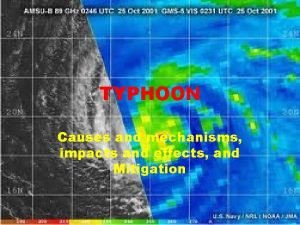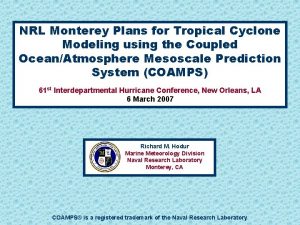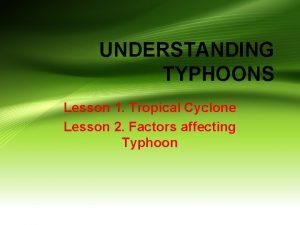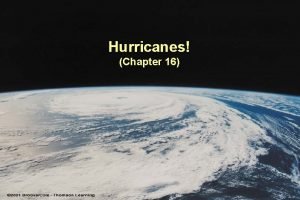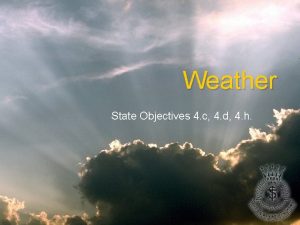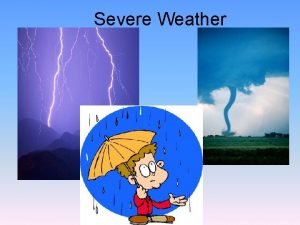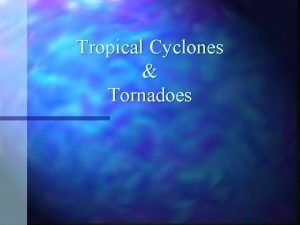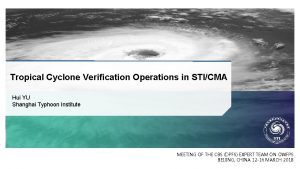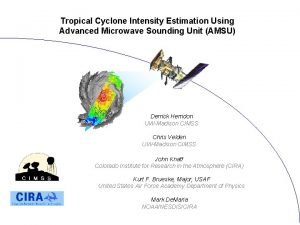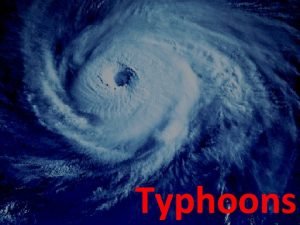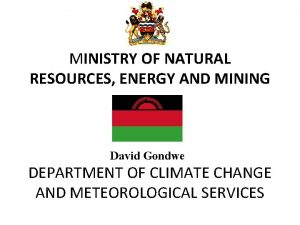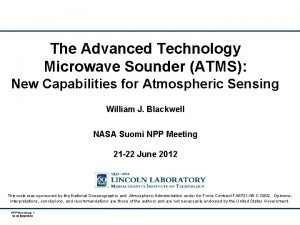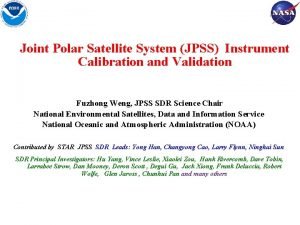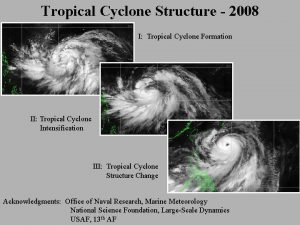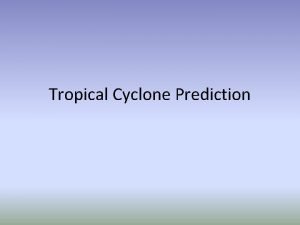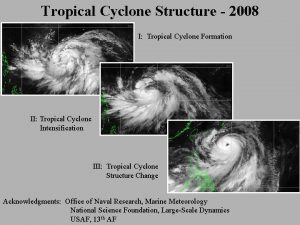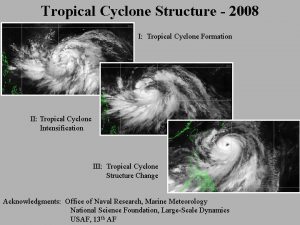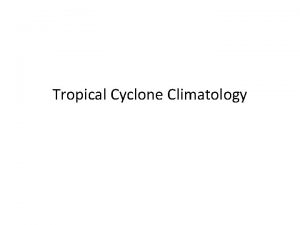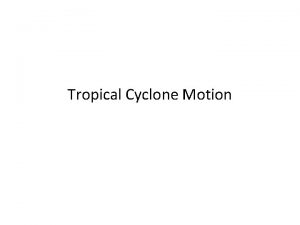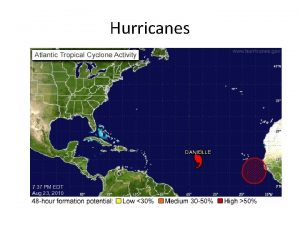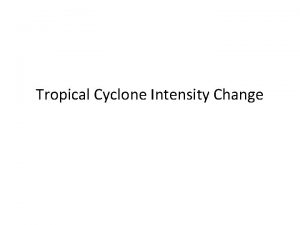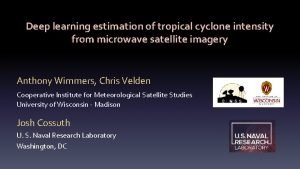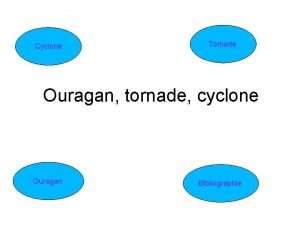Tropical Cyclone Intensity Estimation Using Advanced Microwave Sounding













- Slides: 13

Tropical Cyclone Intensity Estimation Using Advanced Microwave Sounding Unit (AMSU) Derrick Herndon UW-Madison CIMSS Chris Velden UW-Madison CIMSS John Knaff Colorado Institute for Research in the Atmosphere (CIRA) Kurt F. Brueske, Major, USAF United States Air Force Academy Department of Physics Mark De. Maria NOAA/NESDIS/CIRA

Tropical Cyclone Intensity Estimation Using NOAA-KLM Series Advanced Microwave Sounding Unit (AMSU) Warm Core Observations • AMSU flown aboard NOAA 15, 16 and 17 as well as Aqua - 6 estimates per day (2 more with Aqua) • MSLP estimates derived from AMSU-A radiances - Provides measure of upper level warm anomaly magnitude - Channels 7 and 8 located at average ht of anomaly (150 -250 mb) - Anomaly strength directly related to intensity Hurricane Floyd 1999 Hurricane Inez 1966 929 h. Pa

CIRA AMSU Tropical Cyclone Algorithm 1. Retrieve T(x, y, z) from all AMSU-A channels 2. Correct T for rain and ice effects 3. Hydrostatic integration for P(x, y, z) 4. Gradient wind for V(r, z) 5. Statistical Prediction Independent Variables: Parameters from retrieved T, P, V Dependent Variables: Max Wind (Vmax) Min Sea-Level Pressure (MSLP) Azimuthally averaged radii. V(r, Q) of 34, 50, 64 kt winds (r 34, r 50, r 64) 6. Fit parametric wind model to r 34, r 50, r 64 and storm speed to get asymmetric radii Sample r/z tangential wind cross-section from AMSU retrieval (steps 1 -4)

2002 Real-Time Test • Algorithm developed from 1999 -2001 Sample • 2002 Real-Time Runs – Initiated at 00, 06, 12, 18 UTC – Storm positions from ATCF – Analysis restricted to storms within 700 km of AMSU data swath – Results sent to TPC via ftp • Evaluation Samples – 1999 -2001 Developmental cases (N=473) – 2002 All Atlantic/East Pacific cases (N=288) – 2002 Atlantic/East Pacific cases with recon (N=64) • Ground “Truth” for Evaluation – NHC Best Track Vmax and MSLP – NHC Forecast/Advisory for wind radii

Predicted vs. “Observed” Scatter Plots for 2002 Real-Time Runs (Total and Recon-Only Samples) Vmax R 34 MSLP R 50 R 64

Error Summary for CIRA Algorithm: Developmental, 2002 All and 2002 Recon Samples Absolute Error Vmax R 34 MSLP R 50 Variance Explained Vmax and MSLP R 64 Vmax R 34 R 50 R 64 MSLP R 50 R 64

CIMSS AMSU Tropical Cyclone Algorithm • Statistical Method Based on 1999 -2001 regression against recon obs - Linear fit (R 2 = 0. 82) • Channel 7 retrieval used to account for storms near limb • ATCF message provides RMW (Used as a proxy for anomaly size) • Independent estimates in 2002 comparable to Dvorak technique • Improved logic accounts for anomaly height, sub-sampling Resolution ~ 50 km FOV 1 FOV 30

2002 Results for Atlantic Basin Atlantic statistics for AMSU versus Recon (+/- 3 hrs) in h. Pa (N=63) Mean Error Std Dev Bias RMSE 3. 24 2. 29 -0. 42 3. 96 Avg MSLP of sample 1002. 6 Compared to Dvorak (N= 60) in h. Pa Mean Error Std Dev Bias RMSE CIMSS 3. 24 2. 29 -0. 28 3. 95 Avg MSLP of sample 1002. 4 Dvorak 4. 52 3. 40 -0. 90 5. 62

2002 Atlantic Basin Results NOAA/NESDIS Satellite Analysis Branch (SAB) vs. AMSU (N=34, +/- 2 hrs of aircraft reconnaissance) AMSU 81% within +/- 0. 5 T SAB 78% within +/- 0. 5 T

20 Mile Eye Storm on edge of satellite Swath (FOV 3)

Future Work Improve Technique • Bias correction when storm is near satellite limb • Separate treatment of pinhole eye storms using new coefficients • Time averaging / smoothing • Add channel 8 retrieval • Integrate algorithm into NHC/TPC operations • Addition of AMSU on Aqua (2 more passes per day) • Basin specific coefficients (need sufficient “observations”) Confidence Indicator • Measure Based on FOV, eye size (RMW), anomaly height

Summary AMSU provides unique tropical cyclone perspective • Penetrates cloud cover • 55 Ghz region radiances can quantify inner core thermal structure / changes. • Temperature anomaly strength directly associated with tropical cyclone intensity • Skill comparable to, and in some cases better than, the Dvorak estimates • An important new addition to the forecaster “tool kit”

Conclusions from 2002 Evaluation • • • Vmax, MSLP (CIRA): – 2002 (independent) performance very similar to (slightly improved) over dependent sample – Intensity underestimated for small-cored systems Wind Radii (CIRA Method): – 2002 recon-only errors generally similar to dependent sample – Tendency for high bias for R 50 and R 64 – Observed R 50 and R 64 more asymmetric than predicted Addition of second AMSU channel (CIMSS): – Accounts for variability in TC temperature anomaly height Improvements resulting from advanced algorithm logic (CIMSS): – Based on evaluation of 3 years of estimates, continues to evolve Additional improvements foreseen in 2003: – Characterization and new regressions for small-cored storms JHT pathway in 2003: – Continue evaluation of 2002 performance – Implement algorithm upgrades and re-evaluate after 2003 season – If successful and approved, activate improved algorithms at TPC
 Immature stage of typhoon
Immature stage of typhoon Nrl tc
Nrl tc Typhoons
Typhoons Annotated cross section of a tropical cyclone
Annotated cross section of a tropical cyclone Parts of tropical cyclone
Parts of tropical cyclone Map of tornado alley
Map of tornado alley 119-200 kph
119-200 kph Tropical cyclone tornadoes
Tropical cyclone tornadoes Tropical cyclone
Tropical cyclone Tropical cyclone
Tropical cyclone A recipe of a tropical cyclone
A recipe of a tropical cyclone Mining
Mining Advanced technology microwave sounder
Advanced technology microwave sounder Advanced technology microwave sounder
Advanced technology microwave sounder
